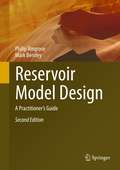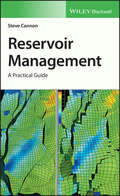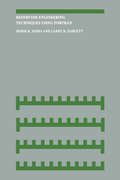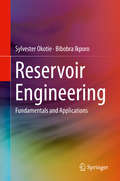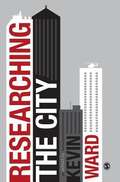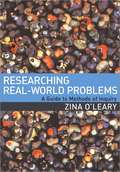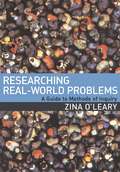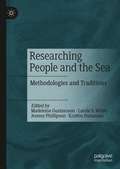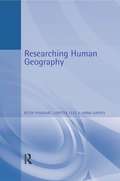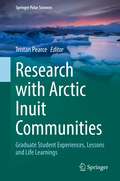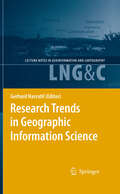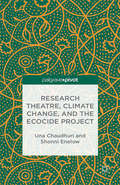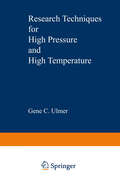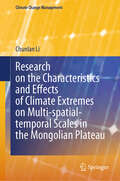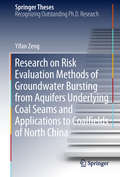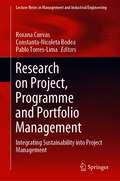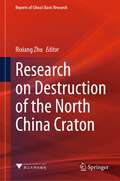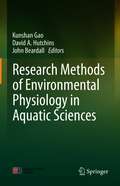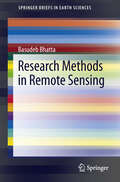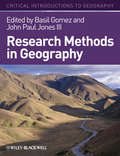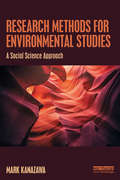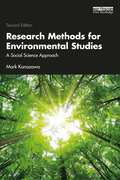- Table View
- List View
Reservoir Model Design: A Practitioner's Guide
by Philip Ringrose Mark BentleyThis book gives practical advice and ready to use tips on the design and construction of subsurface reservoir models. The design elements cover rock architecture, petrophysical property modelling, multi-scale data integration, upscaling and uncertainty analysis. Philip Ringrose and Mark Bentley share their experience, gained from over a hundred reservoir modelling studies in 25 countries covering clastic, carbonate and fractured reservoir types, and for a range of fluid systems – oil, gas and CO2, production and injection, and effects of different mobility ratios. The intimate relationship between geology and fluid flow is explored throughout, showing how the impact of fluid type, displacement mechanism and the subtleties of single- and multi-phase flow combine to influence reservoir model design.The second edition updates the existing sections and adds sections on the following topics:· A new chapter on modelling for CO2 storage· A new chapter on modelling workflows· An extended chapter on fractured reservoir modelling· An extended chapter on multi-scale modelling· An extended chapter on the quantification of uncertainty· A revised section on the future of modelling based on recently published papers by the authorsThe main audience for this book is the community of applied geoscientists and engineers involved in understanding fluid flow in the subsurface: whether for the extraction of oil or gas or the injection of CO2 or the subsurface storage of energy in general. We will always need to understand how fluids move in the subsurface and we will always require skills to model these quantitatively. The second edition of this reference book therefore aims to highlight the modelling skills developed for the current energy industry which will also be required for the energy transition of the future. The book is aimed at technical-professional practitioners in the energy industry and is also suitable for a range of Master’s level courses in reservoir characterisation, modelling and engineering.• Provides practical advice and guidelines for users of 3D reservoir modelling packages• Gives advice on reservoir model design for the growing world-wide activity in subsurface reservoir modelling• Covers rock modelling, property modelling, upscaling, fluid flow and uncertainty handling• Encompasses clastic, carbonate and fractured reservoirs • Applies to multi-fluid cases and applications: hydrocarbons and CO2, production and storage; rewritten for use in the Energy Transition.
Reservoir Management: A Practical Guide
by Steve CannonReservoir management is fundamental to the efficient and responsible means of extracting hydrocarbons, and maximising the economic benefit to the operator, licence holders and central government. All stakeholders have a social responsibility to protect the local population and environment. The process of managing an oil or gas reservoir begins after discovery and continues through appraisal, development, production and abandonment; there is cost associated with each phase and a series of decision gates should be in place to ensure that an economic benefit exists before progress is made. To correctly establish potential value at each stage it is necessary to acquire and analyse data from the subsurface, the planned surface facilities and the contractual obligations to the end-user of the hydrocarbons produced. This is especially true of any improved recovery methods proposed or plans to extend field life. To achieve all the above requires a multi-skilled team of professionals working together with a clear set of objectives and associated rewards. The team’s make-up will change over time, as different skills are required, as will the management of the team, with geoscientists, engineers and commercial analysts needed to address the issues as they arise. This book is designed as a guide for non-specialists involved in the process of reservoir management, which is often treated as a task for reservoir engineers alone: it is a task for all the disciplines involved in turning a exploration success into a commercial asset. Most explorers earn their bonus based on the initial estimates of in-place hydrocarbons, regardless of the ultimate cost of production; the explorers have usually moved on to a new basin before the first oil or gas is produced! This book is not a deeply academic tome, rather the description of a process enlivened by a number of stories and case studies from the author’s forty years of experience in the oil-patch.
Reservoir Management: A Practical Guide
by Steve CannonReservoir management is fundamental to the efficient and responsible means of extracting hydrocarbons, and maximising the economic benefit to the operator, licence holders and central government. All stakeholders have a social responsibility to protect the local population and environment. The process of managing an oil or gas reservoir begins after discovery and continues through appraisal, development, production and abandonment; there is cost associated with each phase and a series of decision gates should be in place to ensure that an economic benefit exists before progress is made. To correctly establish potential value at each stage it is necessary to acquire and analyse data from the subsurface, the planned surface facilities and the contractual obligations to the end-user of the hydrocarbons produced. This is especially true of any improved recovery methods proposed or plans to extend field life. To achieve all the above requires a multi-skilled team of professionals working together with a clear set of objectives and associated rewards. The team’s make-up will change over time, as different skills are required, as will the management of the team, with geoscientists, engineers and commercial analysts needed to address the issues as they arise. This book is designed as a guide for non-specialists involved in the process of reservoir management, which is often treated as a task for reservoir engineers alone: it is a task for all the disciplines involved in turning a exploration success into a commercial asset. Most explorers earn their bonus based on the initial estimates of in-place hydrocarbons, regardless of the ultimate cost of production; the explorers have usually moved on to a new basin before the first oil or gas is produced! This book is not a deeply academic tome, rather the description of a process enlivened by a number of stories and case studies from the author’s forty years of experience in the oil-patch.
Reservoir Engineering Techniques Using Fortran
by Mihir K. Sinha Larry R. PadgettPractical reservoir engineering techniques have been adequately described in various publications and textbooks, and virtually all useful techniques are suit able for implementation on a digital computer. Computer programs have been written for many of these techniques, but the source programs are usually not available in published form. The purpose of this book is to provide a central source of FORTRAN-coded algorithms for a wide range of conventional reservoir engineering techniques. The book may be used as a supplementary text for courses in practical reservoir engineering. However, the book is primarily intended for practicing reservoir engineers in the hope that the collection of programs provided will greatly facil itate their work. In addition, the book should be also helpful for non-petroleum engineers who are involved in applying the results of reservoir engineering analysis. Sufficient information is provided about each of the techniques to allow the book to be used as a handy reference. ix INTRODUCTION This book provides many of the useful practical reservoir engineering (conven tional) techniques used today in the form of FORTRAN codes. The primaI:y objectives have been to provide the simplest possible method for obtaining reli able answers to practical problems. Unfortunately, these codes can usually be applied by simply following a cookbook approach. However, if at all possible, the solutions obtained should be verified and cross-checked by some other means and, most important, should be checked for reasonability.
Reservoir Engineering: Fundamentals And Applications
by Sylvester Okotie Bibobra IkporoThis book provides a clear and basic understanding of the concept of reservoir engineering to professionals and students in the oil and gas industry. The content contains detailed explanations of key theoretic and mathematical concepts and provides readers with the logical ability to approach the various challenges encountered in daily reservoir/field operations for effective reservoir management. Chapters are fully illustrated and contain numerous calculations involving the estimation of hydrocarbon volume in-place, current and abandonment reserves, aquifer models and properties for a particular reservoir/field, the type of energy in the system and evaluation of the strength of the aquifer if present. The book is written in oil field units with detailed solved examples and exercises to enhance practical application. It is useful as a professional reference and for students who are taking applied and advanced reservoir engineering courses in reservoir simulation, enhanced oil recovery and well test analysis.
Researching the City: a Guide for Students (PDF)
by Kevin WardThis practical guide for students focuses on the city and on the different ways to research it. The author explains how research is done, from the original idea to design and implementation, through to writing up and representation.
Researching Real-World Problems: a Guide to Methods of Inquiry (PDF)
by Zina O'LearyThis is the perfect book for any student new to Research Methods. It is brilliantly written, witty, and always easy to understan. Taking as her starting point the need for students to conduct research for themselves in the 'real world', Zina O'Leary guides those new to research through the whys and how-tos of the entire research process.
Researching Real-World Problems: a Guide to Methods of Inquiry (PDF)
by Zina O'LearyThis is the perfect book for any student new to Research Methods. It is brilliantly written, witty, and always easy to understand. Taking as her starting point the need for students to conduct research for themselves in the 'real world', Zina O'Leary guides those new to research through the whys and how-tos of the entire research process. Always student-focused, this book offers a hands on and practical guide to the research process from the initial process of coming up with a good question, via methods of gathering information, through to the writing process itself. Researching Real-World Problems :nbsp; Makes the entire research process a meaningful experience Provides a jargon-busting hands-on guide to the entire research processnbsp; Is illustrated throughout with real-life examplesnbsp; Speaks directly to the needs of the new researcher nbsp; Locates the researcher and research process at heart of a complex web of social structures nbsp; Provides via the Companion Website link above, PowerPoint slides that cover all 12 chapters of the book. They can be printed out as separate transparencies or used in PowerPoint based lectures. They would also be suitable for applications in e-learning// web-based teaching. O'Leary draws her examples from the full range of the Social Sciences, and this is the perfect text for any student in Health, Education or Applied Social Science.
Researching People and the Sea: Methodologies and Traditions
by Madeleine Gustavsson Carole S. White Jeremy Phillipson Kristen OunanianIn this unique edited collection, social scientists reflect upon and openly share insights gathered from researching people and the sea. Understanding how people use, relate to and interact with coastal and marine environments has never been more important, with social scientists having an increasingly vital contribution to make. Yet practical experiences in deploying social science approaches in this field are typically hidden away in field notes and unpublished doctoral manuscripts, with the opportunity for shared learning that comes from doing research often missed. There is a need for reflection on how social science knowledge is produced. This collection presents experiences from the field, its necessary reflexivity and innovation in methods, and the challenges and opportunities of translating across disciplines and policy. It brings to light the tacit expertise needed to study people and the sea and offers lessons which readers could employ in their own research. With a focus on the future direction of marine social sciences, the volume is highly relevant to masters and doctoral students and more experienced researchers engaged in studying people and the sea, as well as policy makers, practitioners and scientists wishing to understand the social dimension of marine and coastal environments. Chapters 2 and 3 are available open access under a Creative Commons Attribution 4.0 International License via link.springer.com.
Researching Human Geography
by Anna Davies Keith Hoggart Loretta LeesResearching Human Geography is an essential new text for any geography student about to embark on a research project. An understanding of how different theories of knowledge have influenced research methodologies is crucial in planning and designing effective research; this book makes this link clear and explores how various philosophical positions, from positivism to post-structuralism, have become associated with particular methodologies.The book gives an overview of a wide range of methods and data collection, both quantitative and qualitative, and explores their strengths and weaknesses for different kinds of research. 'Researching Human Geography' also looks at the various techniques available for the analysis of data, which is presented as an integral and ongoing part of the research process. Clearly written, with extensive use of examples from previous research to show 'methodology in action', this new text is an invaluable addition to both the theory and method of research in human geography.
Researching Human Geography
by Anna Davies Loretta Lees Keith HoggartResearching Human Geography is an essential new text for any geography student about to embark on a research project. An understanding of how different theories of knowledge have influenced research methodologies is crucial in planning and designing effective research; this book makes this link clear and explores how various philosophical positions, from positivism to post-structuralism, have become associated with particular methodologies.The book gives an overview of a wide range of methods and data collection, both quantitative and qualitative, and explores their strengths and weaknesses for different kinds of research. 'Researching Human Geography' also looks at the various techniques available for the analysis of data, which is presented as an integral and ongoing part of the research process. Clearly written, with extensive use of examples from previous research to show 'methodology in action', this new text is an invaluable addition to both the theory and method of research in human geography.
Research with Arctic Inuit Communities: Graduate Student Experiences, Lessons and Life Learnings (Springer Polar Sciences)
by Tristan PearceThis book shares graduate student experiences, lessons, and life learnings from research with Inuit communities in the Canadian Arctic. The results of graduate student research are often disseminated in a thesis or dissertation, but their personal experiences building relationships with Inuit, working together to design and conduct research, and how this shaped their research approach and outcomes, are rarely captured. As such, there are limited resources available to new researchers that share information about the practical aspects of community-based research in the Arctic. The book is intended to provide a glimpse into what it is like to do research together with Inuit, and in doing so, contribute to the development of more productive and equitable relationships between Inuit and researchers. The chapters are written as structured narratives in the first-person and include reflections, and lessons learned.
Research Trends in Geographic Information Science (Lecture Notes in Geoinformation and Cartography)
by Gerhard NavratilIn June/July 2008 the Institute for Geoinformation and Cartography at the Vienna University of Technology organized a scientific colloquium in this city, where 15 well-known scientists presented their ideas on research for the upcoming decade. This book contains papers prepared by the participants as well as by other researchers. The eighteen papers in this book reflect the opinion of a core group of Geoinformation scientists about future research topics. Dealing with these topics poses multiple research questions for the coming years
Research Theatre, Climate Change, and the Ecocide Project: A Casebook
by U. Chaudhuri S. EnelowTheatre is a uniquely powerful site for the kind of thinking called for by the crises of climate change. Encompassing academic research, theatre work-shopping, playwriting, dramaturgy, and theoretical writing, this book offers a practical, theoretical, and critical engagement with the urgent issue of making art in the age of climate change.
Research Techniques for High Pressure and High Temperature
by Gene C. UlmerWithin the last two decades, the experimental technology for the study of high temperature solid-vapor and liquid-vapor equilibria has mushroomed so fast that· both academic and industrial research ers desirous of working in this field -- be they physical chemists, metallurgists, ceramists, petrologists, crystal chemists, or mem bers of any of the several branches of materials science -- find themselves in the situation that in order to learn the art of the latest techniques, a period of apprenticeship or residency needs be spent at an institution or laboratory currently engaged in this type of solid-vapor or liquid-vapor research. The tech niques for control of the vapor phase at total pressures of one atmosphere or greater have not been well defined in the literature. Therefore, the purpose of this volume will be to serve as a labora tory manual for the control, calibration, and measurement of high temperature-high pressure equilibria. The avowed aims of this treatment of experimental techniques are: (1) to give, in terms understandable at the graduate student level, the laboratory procedures necessary to the design and utilization of good experimental technique, (2) to list the limitations, dangers, and technical pitfalls inherent or intrinsic to the described techniques, (3) to give theory and specific data only where they are essential to the experimental design, (4) to give with each chapter references that are extensive enough to serve as a bibliography of the state-of-the-art of technique development within the last decade.
Research on the Characteristics and Effects of Climate Extremes on Multi-spatial-temporal Scales in the Mongolian Plateau (Climate Change Management)
by Chunlan LiCompared with average climate changes, climate extremes which are considered as low-probability events have greater impacts on natural and social systems due to their suddenness, unpredictability and strong destructiveness. Located in the typical arid–semiarid climate transition zone, the Mongolian Plateau, dominated by herbage animal husbandry, is greatly affected by climate extremes, and its ecosystem is extremely fragile. In the context of global warming, the spatial-temporal variation research about climate extremes and their impacts on vegetation is not only beneficial to the protection of the grassland ecological environment in the Mongolian Plateau, but also of great significance to formulate an effective meteorological disaster risk management.Based on daily highest temperature, daily minimum temperature and daily precipitation dataset of 111 meteorological stations over Mongolian Plateau from 1961 to 2014. Firstly, sixteen extreme temperature indices and eleven extreme precipitation indices were calculated. Then, multi-spatial-temporal characteristics of climate extremes in the scope of intensity, duration and frequency were analyzed. At the same time, the vegetation variations were analyzed based on GIMMS NDVI3g data. Thirdly, correlation analysis and multiple stepwise regression analysis were used to analyze the relationships between extreme climate indices and NDVI in different spatial scales from the perspective of single factor and multiple factors, respectively. Finally, the future change of climate extremes in duration were explored based on the climate model data. At the same time, the vulnerable areas of grassland and forest were also identified, and adaptive options of different scales were proposed.Researchers engaged in extreme climate change and managers of government departments are the readership/primary audience for the work.
Research on Risk Evaluation Methods of Groundwater Bursting from Aquifers Underlying Coal Seams and Applications to Coalfields of North China (Springer Theses)
by Yifan ZengThis book provides an information fusion model with information fusion theory, geographic information system technology and modern mathematical methods to evaluate the risks of groundwater inrushes from aquifers underlying coal seams. In this new model, the water inrush vulnerable index was calculated with variable weights theory. It overcomes the defect of the traditional vulnerability index method that assumes constant weights for the factors controlling the water inrush. Mine water inrush events often occur during coal mine construction and production; they account for a large proportion of the nation’s coal mine disasters and accidents in China. Between 2005 and 2014, 513 water inrush incidents have occurred with a total loss of 2,753 lives. As mining depths and mining intensity continue to increase, the hydrogeological conditions encountered are becoming more complex. The innovative model presented here was applied to two coal mines in China with proved better results than the traditional vulnerability index method.
Research on Project, Programme and Portfolio Management: Integrating Sustainability into Project Management (Lecture Notes in Management and Industrial Engineering)
by Roxana Cuevas Constanta-Nicoleta Bodea Pablo Torres-LimaThis book collects recent work presented at the 31st IPMA Congress, which was held in Merida, Mexico, from September 30th to October 2nd, 2019. It covers a range of project, programme and portfolio management contexts, with the general aim of integrating sustainability into project management.The book is structured into three parts. The first part covers concepts and approaches related to the integration of sustainability in project management. The second part presents research on integrating sustainability into project management in different industries and regions. The final part takes specific perspectives on integrating sustainability into project management related to learning and continuing competence development. The book offers a valuable resource for all researchers interested in studying the emerging trends in incorporating sustainability in project, programme and portfolio management.
Research on Destruction of the North China Craton (Reports of China’s Basic Research)
by Rixiang ZhuThis book mainly introduces overview of “Destruction of the North China Craton”, a major research plan of NSFC. It summarizes the scientific ideas, core key scientific issues, scientific research objectives, and models of the major research plan of "Destruction of the North China Craton". From the perspective of major national needs and scientific discipline development, the book focuses on the following aspects: the temporal and spatial distribution range, process, and mechanism of the NCC destruction; the properties, structure, and interaction of materials in different spheres in the earth during craton destruction; the shallow effect of craton destruction; and the control mechanism of mineral resources, energy, and disasters. The book also makes a strategic prospect for the study of global dynamics and improves human understanding of the formation and evolution of continents.
Research Methods of Environmental Physiology in Aquatic Sciences
by Kunshan Gao David A. Hutchins John BeardallThis book presents methods for investigating the effects of aquatic environmental changes on organisms and the mechanisms involved. It focuses mainly on photosynthetic organisms, but also provides methods for virus, zooplankton and other animal studies. Also including a comprehensive overview of the current methods in the fields of aquatic physiology, ecology, biochemistry and molecular approaches, including the advantages and disadvantages of each method, the book is a valuable guide for young researchers in marine or aquatic sciences studying the physiological processes associated with chemical and physical environmental changes.
Research Methods in Remote Sensing (SpringerBriefs in Earth Sciences)
by Basudeb BhattaThis book introduces the overall concepts of research methods in Remote Sensing. It also addresses the entire research framework, ranging from ontology to documentation. As such, it covers the theory while providing a solid basis for engaging in concrete research activities. It is not intended as a textbook on remote sensing; rather, it offers guidance to those conducting research by examining philosophical and other issues that are generally not covered by textbooks. Various stages of research are discussed in detail, including illustrative discussions and helpful references. The topics considered in this book cover a part of the research methodologies explored in Master of Philosophy (M.Phil.) and Doctor of Philosophy (Ph.D.) programs. The book’s physical format has been kept to a compact, handy minimum in order to maximize its accessibility and readability for a broad range of researchers in the field of remote sensing.
Research Methods in Geography: A Critical Introduction (Critical Introductions to Geography #9)
by Basil Gomez John Paul JonesThis comprehensive textbook offers a conceptual and practical introduction to research methodology, data collection, and techniques used in both human and physical geography. Explores a full range of contemporary geographic techniques, including statistics, mathematical analysis, GIS, and remote sensing Unique in both content and organization, it brings together a team of internationally recognized specialists to create a balanced approach between physical geography, human geography, and research techniques Includes a series of foundational chapters offering multiple perspectives on the central questions in research methods Examines the conceptual frameworks and practical issues behind data acquisition and analysis, and how to interpret results Includes explanations of key terminology and exercises throughout
Research Methods for Environmental Studies: A Social Science Approach
by Mark KanazawaThe methodological needs of environmental studies are unique in the breadth of research questions that can be posed, calling for a textbook that covers a broad swath of approaches to conducting research with potentially many different kinds of evidence. Written specifically for social science-based research into the environment, this book covers the best-practice research methods most commonly used to study the environment and its connections to societal and economic activities and objectives. Over five key parts, Kanazawa introduces quantitative and qualitative approaches, mixed methods, and the special requirements of interdisciplinary research, emphasizing that methodological practice should be tailored to the specific needs of the project. Within these parts, detailed coverage is provided on key topics including the identification of a research project; spatial analysis; ethnography approaches; interview technique; and ethical issues in environmental research. Drawing on a variety of extended examples to encourage problem-based learning and fully addressing the challenges associated with interdisciplinary investigation, this book will be an essential resource for students embarking on courses exploring research methods in environmental studies.
Research Methods for Environmental Studies: A Social Science Approach
by Mark KanazawaThe methodological needs of environmental studies are unique in the breadth of research questions that can be posed, calling for a textbook that covers a broad swath of approaches to conducting research with potentially many different kinds of evidence. Written specifically for social science-based research into the environment, this book covers the best-practice research methods most commonly used to study the environment and its connections to societal and economic activities and objectives. Over five key parts, Kanazawa introduces quantitative and qualitative approaches, mixed methods, and the special requirements of interdisciplinary research, emphasizing that methodological practice should be tailored to the specific needs of the project. Within these parts, detailed coverage is provided on key topics including the identification of a research project; spatial analysis; ethnography approaches; interview technique; and ethical issues in environmental research. Drawing on a variety of extended examples to encourage problem-based learning and fully addressing the challenges associated with interdisciplinary investigation, this book will be an essential resource for students embarking on courses exploring research methods in environmental studies.
Research Methods for Environmental Studies: A Social Science Approach
by Mark KanazawaThe methodological needs of environmental studies are unique in the breadth of research questions that can be posed, calling for a textbook that covers a broad swath of approaches to conducting research with potentially many different kinds of evidence. Fully updated to address new developments such as the effects of the internet, recent trends in the use of computers, remote sensing, and large data sets, this new edition of Research Methods for Environmental Studies is written specifically for social science-based research into the environment. This revised edition contains new chapters on coding, focus groups, and an extended treatment of hypothesis testing. The textbook covers the best-practice research methods most used to study the environment and its connections to societal and economic activities and objectives. Over five key parts, Kanazawa introduces quantitative and qualitative approaches, mixed methods, and the special requirements of interdisciplinary research, emphasizing that methodological practice should be tailored to the specific needs of the project. Within these parts, detailed coverage is provided on key topics including the identification of a research project, hypothesis testing, spatial analysis, the case study method, ethnographic approaches, discourse analysis, mixed methods, survey and interview techniques, focus groups, and ethical issues in environmental research. Drawing on a variety of extended and updated examples to encourage problem-based learning and fully addressing the challenges associated with interdisciplinary investigation, this book will be an essential resource for students embarking on courses exploring research methods in environmental studies.
